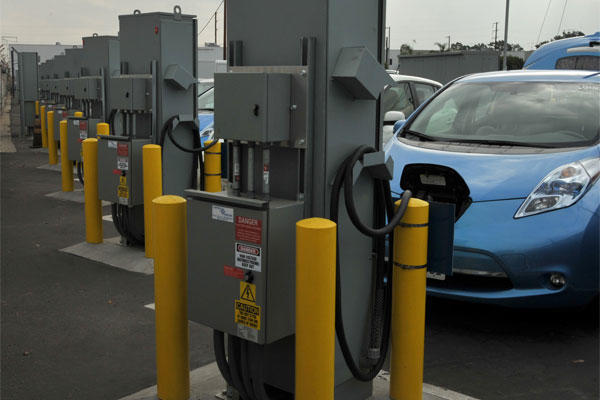WASHINGTON -- Air Force officials unveiled the Department of Defense’s first non-tactical vehicle fleet composed entirely of plug-in electric vehicles, Nov. 14, at Los Angeles Air Force Base, California.
The rollout of the 42-vehicle fleet marks a milestone in the DOD’s demonstration of emerging technology and the vehicles will serve as a resource to the electrical grid when they’re not being driven.
“Everything we do to fly, fight and win requires energy, whether it’s aviation fuel for our aircraft or power to run the bases that support them,” said Secretary of the Air Force Deborah Lee James. “This vehicle-to-grid pilot is a great example of how Airmen are driving the Air Force forward and finding new and innovative ways to make every dollar count.”
The PEV fleet includes both electric and hybrid vehicles ranging from sedans to trucks and a 12-passenger van. The vehicles have the capability to direct power both to and from the electrical grid when they’re not being driven, known as vehicle-to-grid technology. Unique charging stations have been installed on Los Angeles AFB to support the vehicles’ V2G capability.
The V2G technology enables the vehicles to provide more than 700 kilowatts of power to the grid, sufficient power for more than 140 American homes. The vehicles also enhance the power grid’s reliability and security by balancing demand against supply without having to use reserves or standby generators.
California energy providers and regulators worked closely with the Air Force on safety and performance testing as well as technical and regulatory aspects of launching the fleet.
“We absolutely couldn’t have done this without our federal, state and private partners,” said Miranda Ballentine, the assistant secretary of the Air Force for installations, environment and energy. “The shared investment and commitment by our partners illustrates that innovations such as this have value not only to the Air Force and Department of Defense, but to the nation as a whole.”
The Air Force plans to expand the V2G demonstration to Joint Base Andrews, Maryland, and Joint Base McGuire-Dix-Lakehurst, New Jersey. The service will also continue to look for additional capabilities, such as utilizing used batteries as a form of on-base energy storage.
“The forward thinking of the Air Force promises to be an important signal to the market to move this technology into the mainstream,” said William Kempton, the director of the University of Delaware’s Center for Carbon-free Power Integration. “By requesting V2G-capable trucks and cars from several vehicle manufacturers, placed in bases in several states, the Air Force has helped to stimulate demand from both automotive suppliers and the electric industry in these states. We can hope that the Air Force program announced today, together with the recent successful early demonstrations — by the University of Delaware with Honda, BMW, NRG Energy, PJM and others — will move us from demonstration to early commercial-scale products.”
In addition to the PEV fleet in L.A., the Air Force is also investigating the benefits of other alternative fuel vehicles. More than 9,000 ethanol flex fuel vehicles are in the service’s inventory worldwide, along with 50 biodiesel fuel stations on its installations.
“Pursuing this program was an easy decision for us,” James said. “Energy is key to accomplishing the mission, and as the largest energy consumer in the federal government, we are always looking for opportunities to improve our resiliency, reduce our demand and assure our energy supply. From a mission, environmental and fiscal perspective, this program simply makes good sense.”
(Information courtesy of Secretary of the Air Force Public Affairs)




























